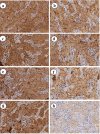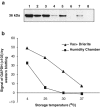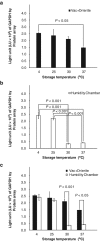Factors influencing the degradation of archival formalin-fixed paraffin-embedded tissue sections
- PMID: 21411807
- PMCID: PMC3201147
- DOI: 10.1369/0022155411398488
Factors influencing the degradation of archival formalin-fixed paraffin-embedded tissue sections
Abstract
The loss of antigenicity in archival formalin-fixed paraffin-embedded (FFPE) tissue sections negatively affects both diagnostic histopathology and advanced molecular studies. The mechanisms underlying antigenicity loss in FFPE tissues remain unclear. The authors hypothesize that water is a crucial contributor to protein degradation and decrement of immunoreactivity in FFPE tissues. To test their hypothesis, they examined fixation time, processing time, and humidity of storage environment on protein integrity and antigenicity by immunohistochemistry, Western blotting, and protein extraction. This study revealed that inadequate tissue processing, resulting in retention of endogenous water in tissue sections, results in antigen degradation. Exposure to high humidity during storage results in significant protein degradation and reduced immunoreactivity, and the effects of storage humidity are temperature dependent. Slides stored under vacuum with desiccant do not protect against the effects of residual water from inadequate tissue processing. These results support that the presence of water, both endogenously and exogenously, plays a central role in antigenicity loss. Optimal tissue processing is essential. The parameters of optimal storage of unstained slides remain to be defined, as they are directly affected by preanalytic variables. Nevertheless, minimization of exposure to water is required for antigen preservation in FFPE tissue sections.
Conflict of interest statement
The author(s) declared no potential conflicts of interest with respect to the authorship and/or publication of this article.
Figures





Similar articles
-
Factors affecting immunoreactivity in long-term storage of formalin-fixed paraffin-embedded tissue sections.Histochem Cell Biol. 2015 Jul;144(1):93-9. doi: 10.1007/s00418-015-1316-4. Epub 2015 Mar 11. Histochem Cell Biol. 2015. PMID: 25757745
-
Immunohistochemistry on old archival paraffin blocks: is there an expiry date?J Clin Pathol. 2017 Nov;70(11):988-993. doi: 10.1136/jclinpath-2017-204387. Epub 2017 Jun 8. J Clin Pathol. 2017. PMID: 28596153
-
Ultrasound-accelerated tissue fixation/processing achieves superior morphology and macromolecule integrity with storage stability.J Histochem Cytochem. 2006 May;54(5):503-13. doi: 10.1369/jhc.5A6802.2005. Epub 2005 Nov 28. J Histochem Cytochem. 2006. PMID: 16314441
-
Microtomy: Cutting Formalin-Fixed, Paraffin-Embedded Sections.Methods Mol Biol. 2019;1897:269-278. doi: 10.1007/978-1-4939-8935-5_23. Methods Mol Biol. 2019. PMID: 30539451 Review.
-
Making Formalin-Fixed, Paraffin Embedded Blocks.Methods Mol Biol. 2019;1897:253-268. doi: 10.1007/978-1-4939-8935-5_22. Methods Mol Biol. 2019. PMID: 30539450 Review.
Cited by
-
The age of paraffin block influences biomarker levels in archival breast cancer samples.Oncol Lett. 2020 Jul;20(1):525-532. doi: 10.3892/ol.2020.11586. Epub 2020 May 4. Oncol Lett. 2020. PMID: 32565978 Free PMC article.
-
Adding the Team into T1 Translational Research: A Case Study of Multidisciplinary Team Science in the Evaluation of Biomarkers of Prostate Cancer Risk and Prognosis.Clin Chem. 2019 Jan;65(1):189-198. doi: 10.1373/clinchem.2018.293365. Epub 2018 Dec 5. Clin Chem. 2019. PMID: 30518666 Free PMC article.
-
Targeted Transcriptional Profiling of Kidney Transplant Biopsies.Kidney Int Rep. 2018 Feb 3;3(3):722-731. doi: 10.1016/j.ekir.2018.01.014. eCollection 2018 May. Kidney Int Rep. 2018. PMID: 29854981 Free PMC article.
-
Validation of a Metastatic Assay using biopsies to improve risk stratification in patients with prostate cancer treated with radical radiation therapy.Ann Oncol. 2018 Jan 1;29(1):215-222. doi: 10.1093/annonc/mdx637. Ann Oncol. 2018. PMID: 29045551 Free PMC article.
-
Colocalization of β-Sheets and Carotenoids in Aβ Plaques Revealed with Multimodal Spatially Resolved Vibrational Spectroscopy.J Phys Chem B. 2024 Jan 11;128(1):33-44. doi: 10.1021/acs.jpcb.3c04782. Epub 2023 Dec 20. J Phys Chem B. 2024. PMID: 38124262 Free PMC article.
References
-
- Arnold MM, Srivastava S, Fredenburgh J, Stockard CR, Myers RB, Grizzle WE. 1996. Effects of fixation and tissue processing on immunohistochemical demonstration of specific antigens. Biotech Histochem. 71:224–230 - PubMed
-
- Beitz E, Schultz JE. 1999. The mammalian aquaporin water channel family: a promising new drug target. Curr Med Chem. 6:457–467 - PubMed
-
- Blind C, Koepenik A, Pacyna-Gengelbach M, Fernahl G, Deutschmann N, Dietel M, Krenn V, Petersen I. 2008. Antigenicity testing by immunohistochemistry after tissue oxidation. J Clin Pathol. 61:79–83 - PubMed
-
- Camp RL, Charette LA, Rimm DL. 2000. Validation of tissue microarray technology in breast carcinoma. Lab Invest. 80:1943–1949 - PubMed
Publication types
MeSH terms
Substances
Grants and funding
LinkOut - more resources
Full Text Sources
Other Literature Sources

